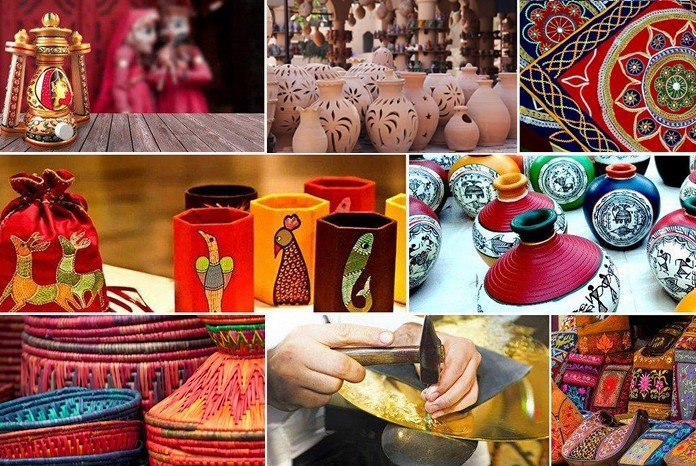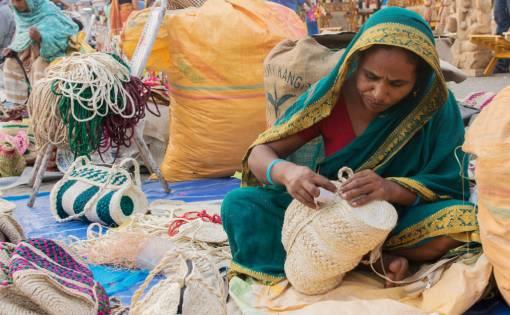
The creative manufacturing and handmade (CMH) industry has been growing all over the world. It is anticipated to soar to USD 1 trillion by 2024 from a value of USD 700 billion in 2022. Conscious consumerism—the preference for goods and methods that are environmentally sustainable, socially inclusive, equitable, regional, and invariably artisanal—drives this upward arc of market forces. The Sustainable Development Goal (SDG) 12 of responsible consumption and production is met by these imperatives.
India’s own handmade industry has been expanding concurrently. Its exports reached USD 4.35 billion in FY 2021–22, an increase of 25.7 percent from the prior year. In addition to foreign exchange, the sector’s earnings are mostly based domestically. The Indian government estimated the handicraft and handloom sector to be worth INR 25,706.3 crore (roughly USD 3 billion) in FY 2020–21. This conservative estimate is due to the nature of the industry, which operates both inside and outside the formal economy, through online retail, organised craft fairs, tourist market stalls, and doorstep sales. Retail companies that have increased their social and artisanal business ties recently have given demand an additional boost.

The CMH industry, which employs almost 200 million craftspeople and has the second-largest workforce after agriculture, has immense potential if it is simplified, institutionalised, and equipped with the right technologies. This can be achieved through its contribution to the GDP of the country, as well as by fostering new livelihoods, expanding India’s entrepreneurial ecosystem, and achieving a number of SDGs along the way, including gender equality and climate action through the use of more environmentally friendly supply chains. The sector’s potential has never been higher, but a crucial element—finance—determines whether it plods along or makes a quantum leap towards new opportunities.
Why money is important
Micro, small, and medium-sized businesses (MSMEs), which are predominantly found in rural India and have their roots in a variety of cultural traditions, make up the majority of businesses in the handcrafted sector. These handmade and craft-based MSMEs (HCMs) include craftsmen and creative producers that carry the full farm-to-consumer value chain and support numerous sectors of the cultural economy, including fashion, home decor, and tourism.
Financial instability makes it impossible to scale up or even continue in the handcrafted industry.
Despite its growth and promise, HCMs struggle to find the funding and investment necessary to modernise and scale up their operations. A huge USD 397 billion loan gap exists for MSMEs, claims one report. In addition to attracting new customers, strengthening and diversifying supply chains, and catalysing innovation in raw material, product, and organisation design, finance also paves the way for marketing and retail via digital platforms, which in turn helps to create businesses, livelihoods, and communities. Unstable finances have the potential to completely ruin a sector, even while scaling up.
The COVID-19 pandemic, which caused an estimated 22 percent of artisans to lose 75% of their yearly revenue, served as a sharp reminder of this. A dipstick survey found that while sales for 70% of the craftsmen plummeted by more than 75%, 40% of them were forced to stop production for the duration of the epidemic due to a lack of operating capital to maintain operations.
Conditions of estrangement
The epidemic, nevertheless, also served as a turning point. It hastened the shift to online sales and enlarged domestic and foreign markets almost immediately, ushering in a new business-to-consumer model for the industry that eliminated the middleman. HCMs are now keen to take the jump after being more aware of the sea of opportunities in sales and collaborative collaborations. According to a report by 200 Million Artisans (200M) titled Financing a Handmade Revolution: How Catalytic Capital Can Jumpstart a Handmade Economy, 95% of HCMs surveyed have sophisticated, digitalized methods of receiving payments, and 89% are concentrated on enhancing brand, growth, and profitability. Nevertheless, just one in ten people have easy access to the money they need to make this happen.
Here are a few things that hinder the sector’s expansion.
1. Capital availability
The funding requirements of HCMs vary depending on where they are in their business journey, but more than two-thirds require some sort of financing. According to a report by 200M, in order to scale, about 85% of HCMs require high-risk growth capital; 78% require working capital to pay for designers, artisans, raw materials, logistics, etc.; 80% require funding for innovation and experimentation; and 72% require it for impact measurement and communication. To scale up, HCMs frequently rely on their own savings, borrow through unofficial networks, or reincorporate their revenues.
The majority of HCMs fall into the category of the “missing middle,” being both too big and too small to qualify for bank loans, impact investments, and commercial investors.
Because of this, 88 percent of HCMs finance their operations on their own, while 65 percent prefer to rely on advances against orders. The mainstream financing channels, such as CSR offices, private investors, microfinance institutions, and handicraft councils, only cover less than 5% of the funding needs of the CMH sector. 45 percent of people avoid banks.
2. The capitalization of women

Women, who control more than 20% of MSMEs in the nation and make up a sizable portion of the artisan workforce, face additional challenges. Women find it more difficult to obtain financing since they typically have fewer or no collaterals to pledge, less mobility, and lower levels of financial literacy than men. While 62 percent of women-led HCMs find it difficult to talk to investors, compared to 48 percent of men-led HCMs, fifty-five percent of women-led HCMs are unaware of the funding possibilities accessible to them. These are some of the factors that contribute to the self-financing dependence of 56 percent of women-led HCMs versus 36 percent of men-led HCMs.
3. Investor participation
The majority of HCMs rely on their own resources despite the fact that they now have access to alternative financing instruments like convertible notes, purchase order financing, blended finance, and social impact bonds. They are wary of the paperwork, collaterals, and incompatible lending terms (like credit worthiness) stipulated by banks, non-banking financial companies (NBFCs), and traditional financing channels. In addition to having limited awareness of new funding options, HCMs also struggle to communicate with investors, speak their language, and give them the growth structures and (difficult-to-measure) impact statistics they require. Finding, gaining access to, and interacting with investors are big problems, according to 74% of HCMs.
4. A weak ecosystem for startups and policy
The industry needs to join a cooperative network of incubators, accelerators, and think tanks that can understand its unique problems and provide tailored solutions, such as offering pertinent market information, reasonably priced due diligence and compliance, and public good resource repositories and tools for monitoring and evaluation. 88 percent of HCMs polled by 200M turn to their founders, friends, and relatives for resources and counsel.
The path to government policies and programmes is paved with impediments.
The road to government policies and programmes is paved with difficulties in the absence of a collaborative environment. They include the tangle of bureaucracies this large and diverse sector must negotiate, the intricate regulations governing GST structures, tax exemptions, and incentives, and the sporadic and confusing information surrounding them that it must comprehend. According to the study, 41% of HCMs have trouble making GST payments, and 45% find it difficult to expand up without an industry accreditation.
Catalytic capital is a remedy
Only a small number of investors, accelerators, and incubators provide funding and support for the CMH sector. What HCMs require is a new, specialised financing and funding model that is compatible with their various work cultures and modalities of production. The CMH sector is in need of transformation, and catalytic capital, a kind of investment that is patient, forgiving, adaptive, and risk-taking, is the way to go.
Impact investors, family foundations, corporate social responsibility organisations, and retail givers—actors who haven’t traditionally made investments in the sector—could play a crucial role in providing the CMH sector with specialised investment options. The paper emphasises the potential for catalytic capital to:
- De-risk innovation pipelines and encourage fresh thinking along various value chains.
- Increase the MSMEs’ credibility, investment readiness, and impact potential so they can grow and draw in more funding.
- Allow first-mile artisan groups to be formally included, and encourage well-known start-up players to actively participate in the CMH ecosystem
- Create an atmosphere that is conducive to achieving impact goals in order to accelerate SDG impact and policy action.
- By providing “better conditions for better impact” to market-based HCMs, you may increase responsibility and provide incentives for impact development.
A road map for revolution
In the CMH sector, the time is right for a revolution, but tipping the scales will require cooperation from all parties. Following are some suggestions from the report:Sector-specific, creativity-driven portfolios with a focus on ethical consumption and production can be created by investors and funders. In order to create catalytic capital solutions that de-risk financing for the CMH sector, they must collaborate with charitable and policy actors.By supporting sector-specific data mapping, developing a single-window policy for schemes, grants, and information, and reducing the compliance cost by streamlining legislative frameworks, policymakers should foster an environment that is favourable to HCMs and investors.Infrastructure for the public benefit can be built by ecosystem actors to facilitate collaboration and communication among the many sector players. They can use technology to help stakeholders access data, market intelligence, and market access networks, and they can help investors and policymakers allocate the necessary resources to various demands throughout the farm-to-consumer value chain.Businesses should look for access to tools, resources, and cooperative networks and develop a distinct value proposition based on a knowledge of the aware customer and any gaps in the value chain.Technology advancements, new business models, a developing entrepreneurial climate, and a growing market have brought India’s handmade and creative manufacturing industries to the brink of transformation. According to one research, the country lacks low-skilled manufacturers for the clothing and textile industries alone, a deficit that, given the appropriate circumstances, the CMH industry may readily fill. Nevertheless, those circumstances can only be created when technology, capital, and policy work together. When it happens, we’ll have a handcrafted revolution that actually accomplishes its goals.
Also read
In both Delhi, Punjab, AAP govts allege ‘flood politics’, tread water



